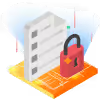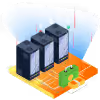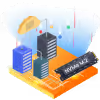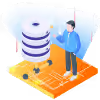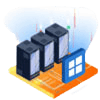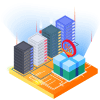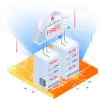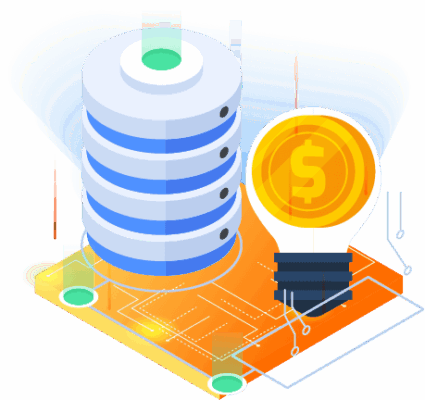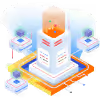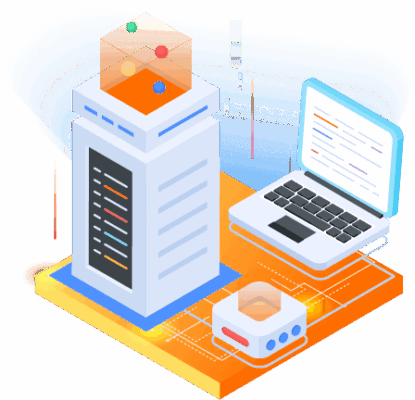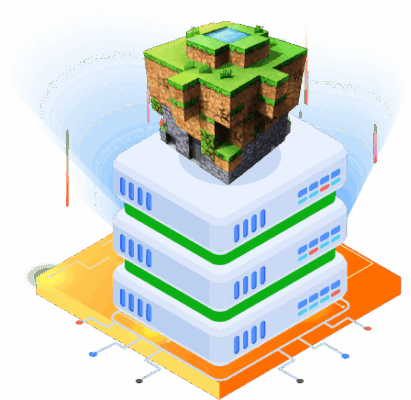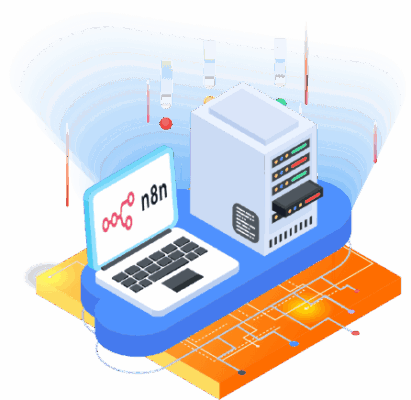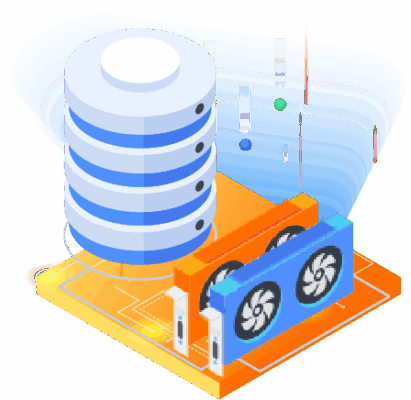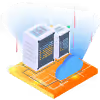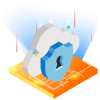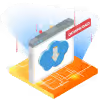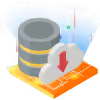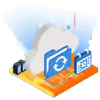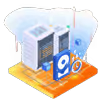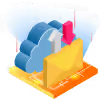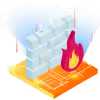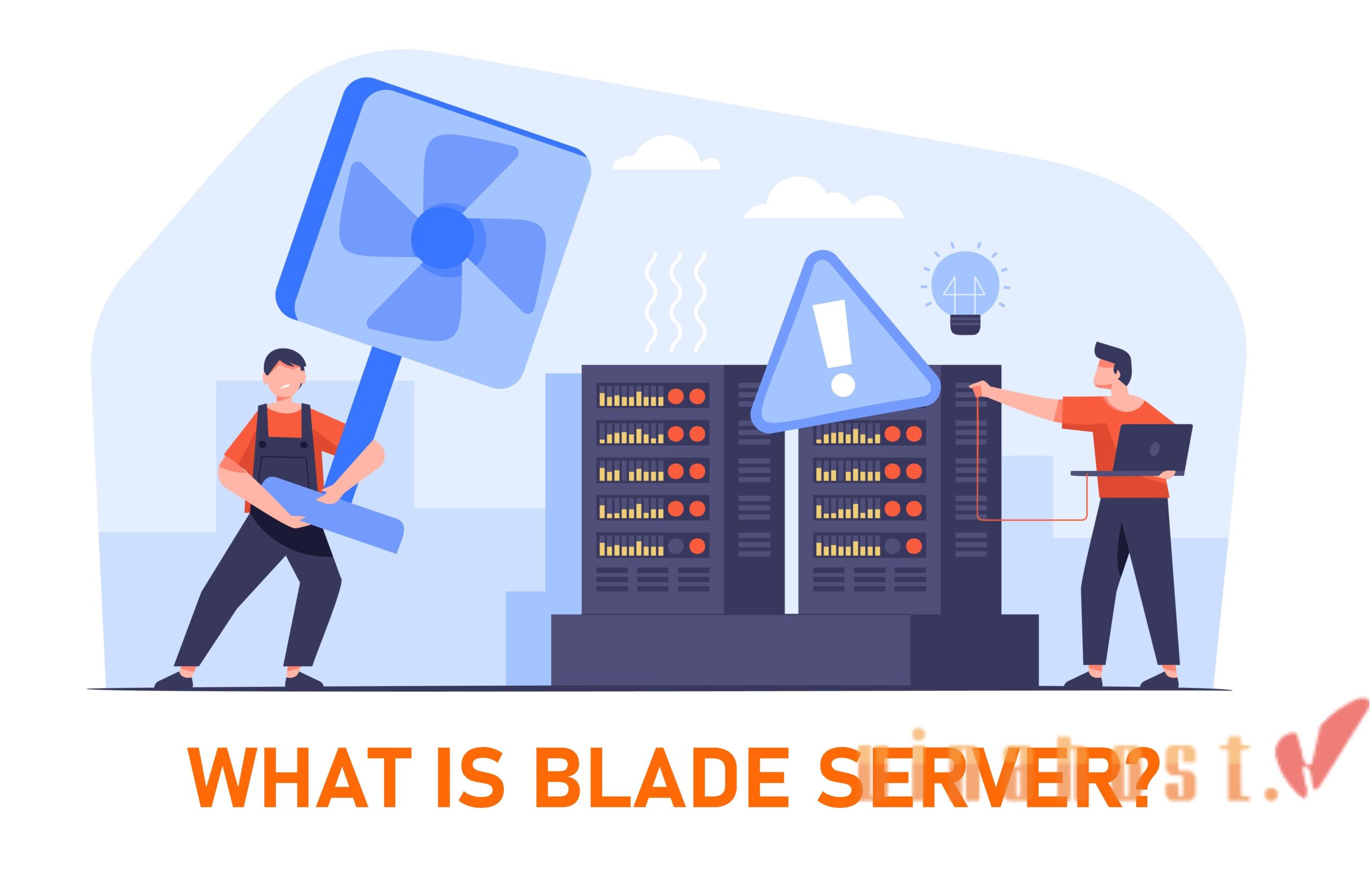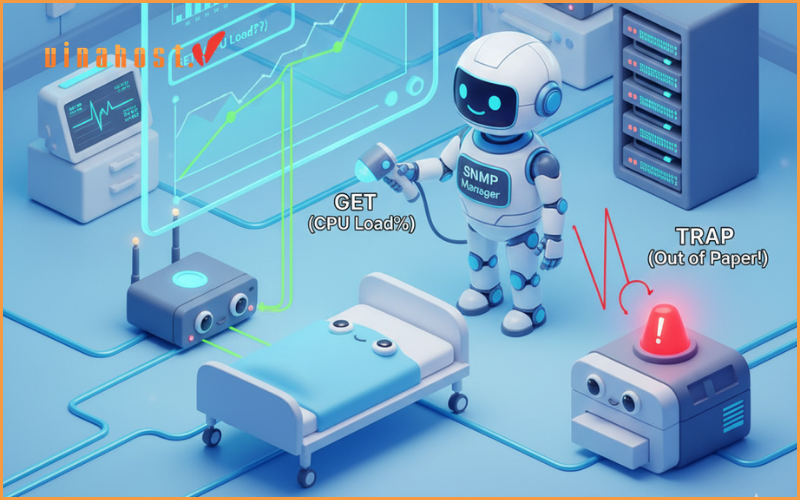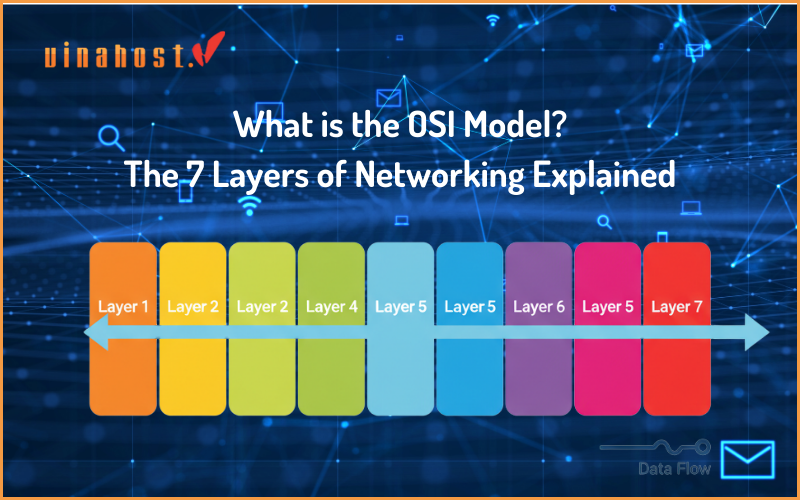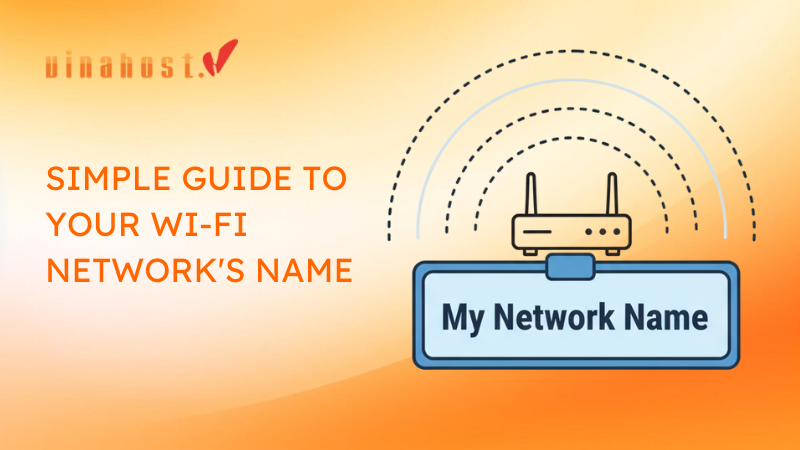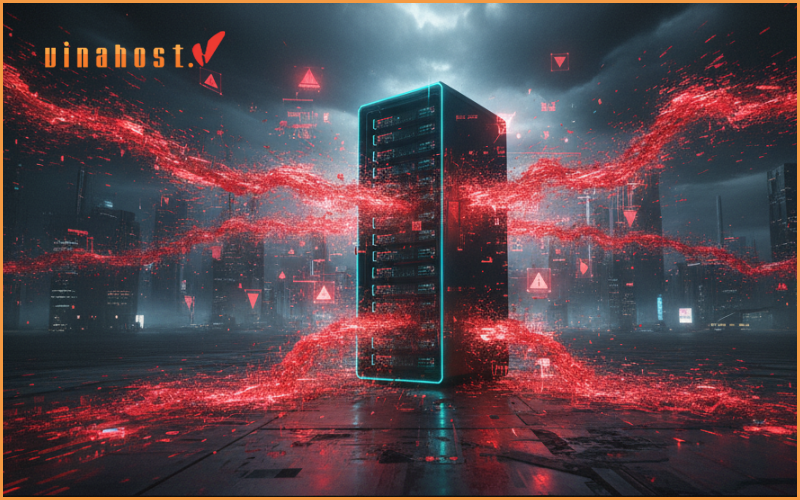In the realm of data centers and server infrastructure, the term “blade server” is mentioned as a powerful solution for maximizing efficiency and performance. But what is blade server, and how does it revolutionize traditional server setups? This VinaHost‘s article dives into the concept of blade servers, exploring their design, functionality, and the benefits they offer to businesses and organizations. Understanding the intricacies of blade servers is crucial for harnessing their full potential in optimizing data center operations and meeting the ever-growing demands of modern computing environments.
1. What is Blade Server?
What is a Blade Server? A blade server is a compact, modular computing device that is designed to efficiently utilize space and resources in a data center. It is a form of server architecture where multiple thin, modular server units, known as blades, are housed in a common enclosure or chassis. Each blade functions as an independent server with its own processors, memory, storage, and network interfaces.
Blade server definition – key features:
- Modularity: Blades are individual server modules that can be added or removed from the chassis without affecting the overall infrastructure. This modularity allows for easy scalability and upgrades.
- Space Efficiency: Blade servers are known for their high-density design, enabling a significant number of servers to be housed in a relatively small physical space. This is especially advantageous in data centers where space is a premium.
- Shared Resources: The common enclosure, or chassis, provides shared resources such as power supplies, cooling, and networking infrastructure. This shared infrastructure helps reduce overall power consumption and cooling requirements compared to traditional rack-mounted servers.
- Reduced Cable Clutter: The design of blade servers often involves a reduction in cable clutter, as many of the connections are managed within the enclosure. This helps improve airflow, simplify maintenance, and enhance the overall organization of the data center.
- Centralized Management: Blade servers typically come with centralized management tools that allow administrators to monitor and control multiple blades from a single interface. This simplifies server management tasks and facilitates rapid provisioning and configuration changes.
- Hot-Swappability: Blades are often hot-swappable, meaning they can be inserted or removed from the chassis without shutting down the entire system. This feature improves system availability and reduces downtime during maintenance or upgrades.
- Resource Sharing and Optimization: Blade servers share common resources, and excess capacity in one blade can be dynamically allocated to another through resource pooling. This flexibility enhances resource optimization and efficiency.
2. What is server blade’s role in modern data centers?
Blade servers play a crucial role in modern data centers, offering several important advantages that contribute to the efficiency, scalability, and management of IT infrastructure
Space Optimization:
Traditional rack-mounted servers take up considerable space in data centers. Data centers often face limitations on physical square footage.
Blade servers, with their compact size, allow cramming in more processing power per unit of space. This translates to a significant increase in data center efficiency, allowing you to fit more servers without expanding the physical footprint.
Scalability and Flexibility:
Data center needs can fluctuate. Blade servers offer exceptional scalability. Adding or removing blade servers from the chassis is a quick and straightforward process.
This allows you to easily adjust your computing resources to meet changing demands. Need to handle a surge in website traffic? Simply add more blades. Need to decommission an underutilized server? Just remove the blade. This flexibility ensures you have the right amount of processing power available at any given time.
Simplified Management and Lower TCO (Total Cost of Ownership):
Blade servers come with a centralized management system through the chassis. This allows administrators to monitor, configure, and update multiple blades simultaneously, saving significant time and effort compared to managing individual servers.
Additionally, shared resources within the chassis like power supplies and cooling systems reduce redundancy and can lead to lower overall power consumption. This translates to a potentially lower Total Cost of Ownership (TCO) in the long run.
Improved Power Efficiency:
Traditional servers often have their own power supplies and cooling systems, leading to wasted energy. Blade server chassis house shared, high-efficiency power supplies and cooling systems that cater to all the blades within.
This not only reduces redundancy but also allows for optimized power distribution and cooling, leading to a more energy-efficient data center environment.
Ideal for Virtualization:
Blade servers are perfectly suited for virtualized environments where a single physical server can host multiple virtual machines. The modular design and centralized management of blade servers make them ideal for efficiently allocating resources and managing virtual machines.
Also Read: What is a Dedicated Server? | How Does a Dedicated Server Work?
3. What Are the Components of a Blade Server?
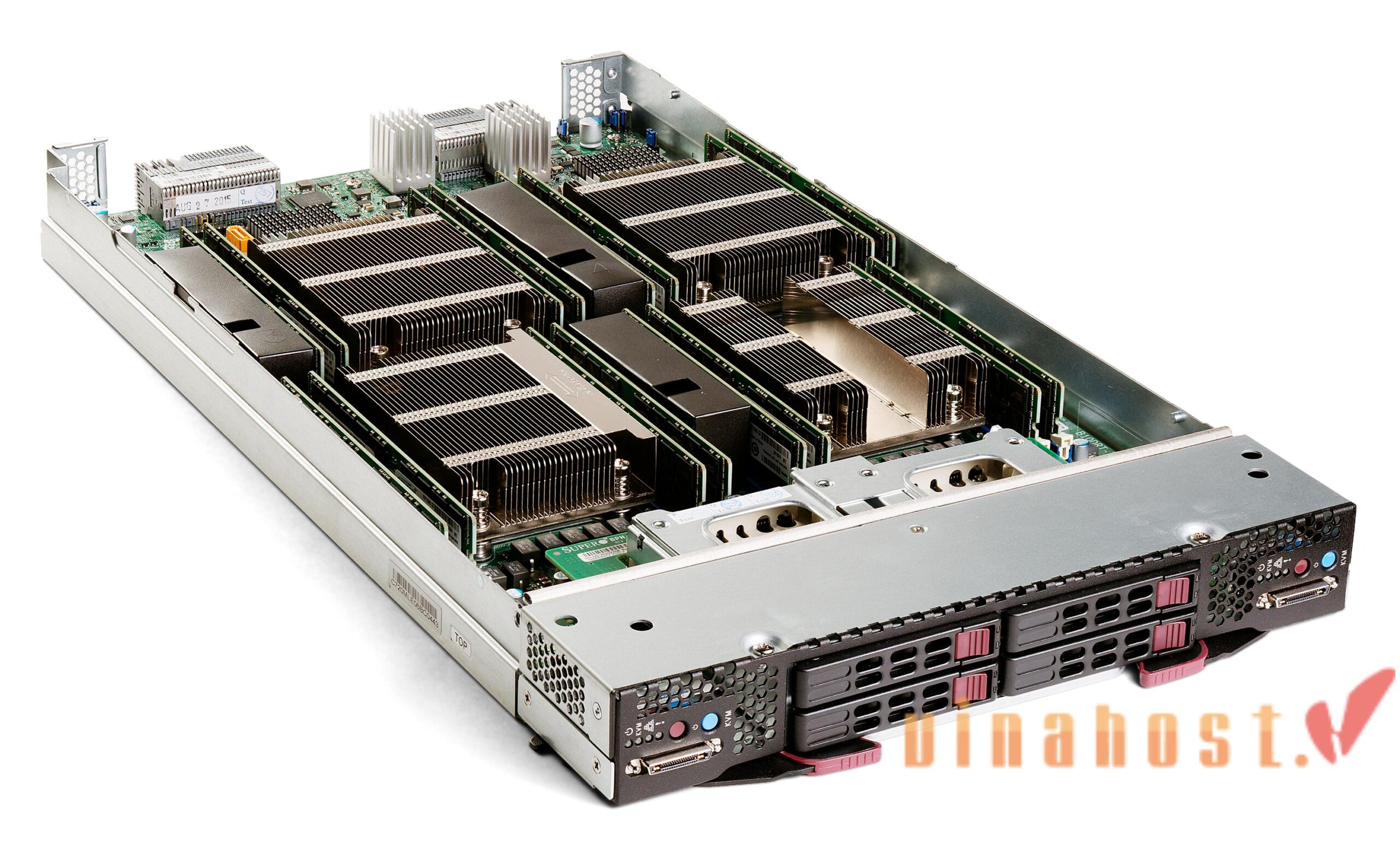
3.1. Blade chassis
It’s a specialized enclosure that provides the physical structure and shared resources for the blade servers (modules). The chassis typically includes:
- Backplane: A high-speed connection hub that interconnects all the blades within the chassis, facilitating communication and data exchange between them.
- Power supplies: Shared high-efficiency power supplies distribute power to all the blades.
- Cooling system: A centralized cooling system ensures proper heat dissipation for all the blades within the chassis.
- Network switches: May be integrated to provide network connectivity for the blades.
- Management module (optional): Some chassis have a dedicated management module for centralized monitoring and control of all the blades in the system.
3.2. Blade modules
These are the individual server units that slide into the chassis. Each blade module is a self-contained computer system with its own:
- Central Processing Unit (CPU): The brain of the blade, responsible for processing instructions.
- Memory (RAM): Provides temporary storage for data used by the CPU.
- Storage (optional): Some blade modules may have built-in storage devices like solid-state drives (SSDs) for local data storage.
- Network Interface Card (NIC): Enables network connectivity for the blade server.
3.3. Management modules
While some blade chassis have a dedicated management module, it’s not always a separate component. Management functionalities can also be integrated into the chassis itself or even a separate blade module. The role of the management module is to:
- Monitor the health and status of all the blades within the chassis, including CPU temperature, memory usage, and power consumption.
- Provide a centralized interface for configuration, updates, and deployment of software across all blades.
- Simplify troubleshooting and maintenance tasks.
Also read: What is a Web Server & How Web Servers Work?
4. How Blade Server Work?
Blade servers work by combining modular hardware components in a centralized enclosure to create a highly efficient and scalable computing infrastructure.
Blade server explained: How it work?
Deployment:
- Blade chassis are installed within server racks in the data center.
- Individual blade server modules are inserted into the slots provided on the front of the chassis. These blades can be pre-configured with specific hardware components (CPU, memory) based on their intended use.
Power Up and Communication: Once powered on, the blades establish communication with the backplane within the chassis. This high-speed connection hub allows the blades to exchange data and communicate with each other, as well as with external networks.
Shared Resources: The blade chassis provides shared resources like power supplies and cooling systems to all the blades. This eliminates the need for each blade to have its own power supply and cooling unit, reducing redundancy and improving efficiency.
Centralized Management: The chassis, or a dedicated management module, provides a centralized point of control for administrators. This allows them to:
- Monitor the health and performance of all blades within the chassis (CPU usage, memory, temperature).
- Configure and update the blades remotely.
- Deploy operating systems and applications across multiple blades simultaneously.
Scalability:
- A key advantage of blade servers is their modular design. Adding more processing power is as simple as inserting additional blade modules into the chassis, as space allows and power capacity permits.
- Conversely, removing underutilized blades from the chassis is a quick process, allowing for efficient resource allocation based on changing needs.
Virtualization: Blade servers are ideally suited for virtualized environments. A single physical blade server can run multiple virtual machines, each acting as a separate server with its own operating system and applications. This allows for efficient utilization of resources and simplifies server management.
Security: Security measures are implemented at the blade level (operating system hardening) and the chassis level (physical access controls). Network security is typically configured at the network switch or firewall level within the data center.
5. Advantages of Blade Servers
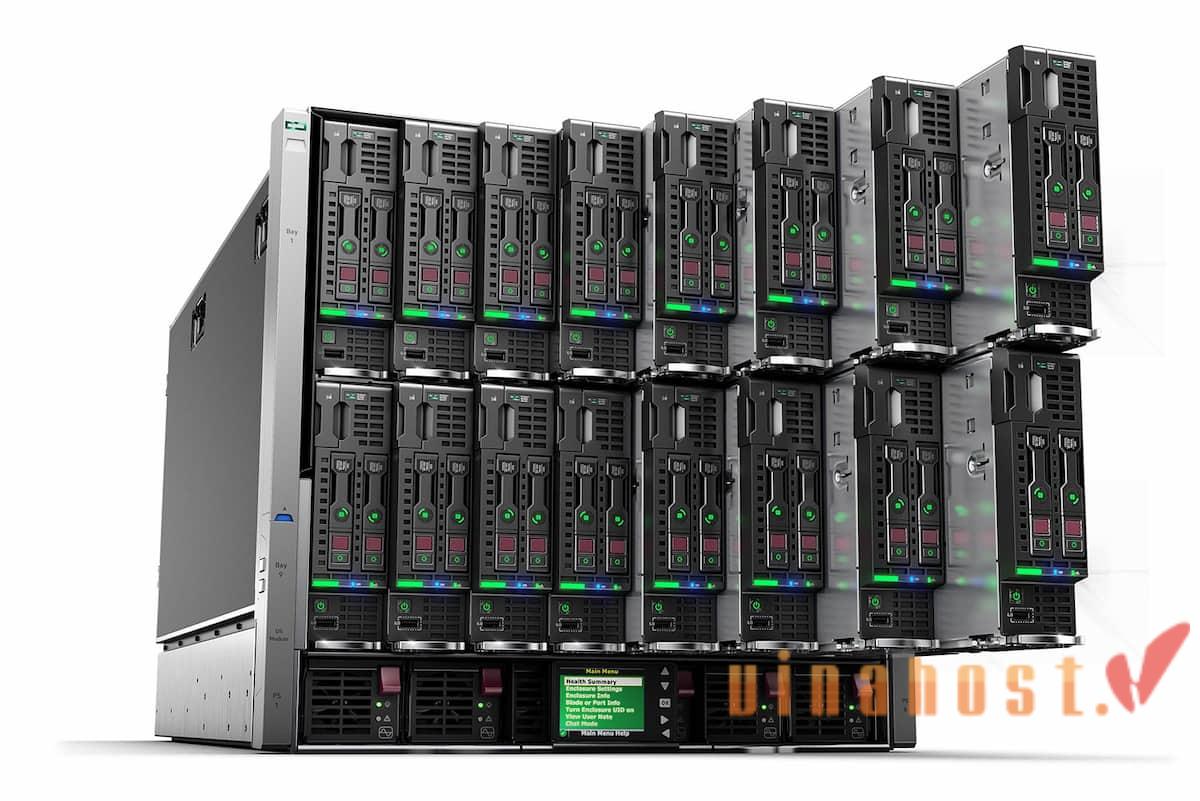
5.1. Space Efficiency
Blade servers offer high-density computing, allowing multiple server modules to be housed in a compact chassis. This space-efficient design is ideal for data centers with limited floor space.
5.2. Scalability and Flexibility
The modular nature of blade servers enables easy scalability. Organizations can add or replace individual blade modules to meet growing computational needs, providing flexibility in resource allocation.
5.3. Centralized Management
Blade servers often feature centralized management tools, allowing administrators to monitor and control multiple blades from a single interface. This centralized management simplifies configuration, monitoring, and maintenance tasks.
5.4. Enhanced Power Efficiency
Shared power supplies and cooling mechanisms within the blade chassis contribute to enhanced power efficiency. Blade servers optimize power consumption, reducing overall energy costs in the data center.
5.5. Streamlined Cabling
Blade servers reduce cable clutter through centralized connectivity within the chassis. This streamlined cabling enhances airflow, simplifies maintenance, and contributes to a cleaner and more organized data center environment.
Also read: What is a Nameserver? | A Comprehensive Guide for Beginners
6. Disadvantages of Blade Servers
![what is blade server 1 4 - #1 Hosting Giá Rẻ, VPS Giá Rẻ, Email, Cloud Server | VinaHost.VN [What is Blade Server]](https://static.vinahost.vn/wp-content/uploads/2024/03/what-is-blade-server-1-4.jpg)
Here are some common disadvantages of blade servers:
Higher Upfront Cost: While blade servers offer advantages in space efficiency and management, the initial cost can be higher compared to traditional rack servers. The cost includes the blade chassis itself, along with the individual blade modules you populate it with. For high-performance configurations, the cost can be significant.
Vendor Lock-In: Blade servers are not universally compatible. Blades are typically designed to work with a specific chassis, often from the same vendor. This can limit your flexibility in terms of choosing components and potentially lock you into a particular vendor’s ecosystem for future upgrades or replacements.
Single Point of Failure: A major concern with blade servers is the potential for a single point of failure. Since multiple blades reside within a single chassis, a critical hardware failure in the chassis itself (power supply, cooling system) can impact all the blades housed within it. This can lead to downtime for multiple servers if the chassis component fails.
Limited Upgradeability: Upgrading individual components within a blade server can be more complex compared to traditional rack servers. Depending on the design, some blades might require replacing the entire blade for significant upgrades like CPU or memory. This can be less flexible and potentially more expensive than upgrading components in a traditional server.
Heat Management: Packing multiple high-performance servers into a compact space like a blade chassis can generate significant heat. While the chassis typically has built-in cooling systems, ensuring adequate airflow and heat dissipation is crucial for optimal performance and reliability of the blades. Improper cooling can lead to overheating and potential server failures.
7. Exploring Blade Server Applications
7.1. Virtualization
Blade servers are a perfect fit for virtualized environments. A single physical blade server can be virtualized to run multiple virtual machines, each acting as a separate server with its own operating system and applications. This allows for:
- Increased Server Utilization: Consolidate multiple physical servers onto fewer blades, maximizing resource usage and reducing hardware costs.
- Improved Agility: Provisioning and deploying new virtual machines on blades is faster and more efficient compared to traditional physical servers.
- Simplified Management: Centralized management of blades simplifies managing virtual machine deployments across the infrastructure.
7.2. High-Performance Computing (HPC)
HPC applications require a lot of processing power and fast communication between compute nodes. Blade servers can be clustered together to create powerful HPC environments for tasks like:
- Scientific simulations: Modeling complex physical phenomena or running large-scale simulations.
- Data analysis: Processing and analyzing massive datasets in fields like genomics or weather forecasting.
- Engineering design: Running complex simulations for product design and development.
7.3. Cloud Computing
Cloud service providers rely on robust server infrastructure to deliver their services. Blade servers offer a scalable and efficient solution for cloud deployments due to:
- Scalability: Cloud providers can easily add or remove blades to meet fluctuating demands for processing power.
- Density: Blade servers allow cramming in more processing power per unit space, optimizing data center footprint.
- Centralized Management: Managing a large pool of blade servers simplifies cloud infrastructure management.
7.4. Edge Computing
Edge computing brings data processing closer to the source of data collection, often in remote or distributed locations. Blade servers can be deployed in edge environments for tasks like:
- Real-time data processing: Analyzing sensor data from IoT devices for quick decision-making.
- Content caching: Delivering content faster to users by caching it at the edge of the network.
- Traffic management: Processing and analyzing network traffic data for network optimization.
Also read: What is VPS? | Unveiling the Power Behind Virtual Private Servers
8. Factors to Consider when Choosing Blade Servers

8.1. Performance and processing capabilities
- Workload demands: Identify the type of workloads your blades will handle (virtualization, HPC, etc.) and the processing power required (CPU cores, clock speed).
- Memory requirements: Consider the memory needs of your applications and the amount of RAM supported by the blades.
- Storage options: Determine if local storage on the blades is necessary or if you’ll rely on a centralized storage solution.
8.2. Scalability and expansion options
- Future growth: Project your future computing needs and choose blades that can be easily scaled up by adding additional blades to the chassis.
- Blade chassis capacity: Consider the number of blade slots available in the chassis and if it aligns with your current and future server requirements.
- Upgradeability: Evaluate how easily individual components within the blades can be upgraded (CPU, memory) to accommodate changing needs.
8.3. Compatibility with existing infrastructure
- Network connectivity: Ensure the blades are compatible with your existing network infrastructure (network adapters, switches).
- Management software: Verify compatibility with your existing data center management tools for seamless integration.
- Operating systems: Confirm the blades support the operating systems you plan to run on your virtual machines or containers.
8.4. Vendor support and reliability
- Vendor reputation: Research the vendor’s reputation for blade server quality, reliability, and customer support.
- Warranty coverage: Understand the warranty terms offered by the vendor and consider extended warranty options for critical deployments.
- Support availability: Ensure the vendor offers adequate technical support options to address any issues that might arise.
Also read: What is Mail Server? | The Importance of Mail Servers
9. Future Trends in Blade Server Technology
9.1. Integration of advanced technologies (AI, ML)
- AI-powered Management: Blade server management could leverage AI for tasks like workload optimization, predictive maintenance, and automated resource allocation. This could lead to more efficient resource utilization and proactive problem-solving.
- Machine Learning for Performance Optimization: Machine learning algorithms could analyze blade server performance data and automatically adjust settings for optimal performance and power efficiency.
9.2. Energy efficiency improvements
- Advanced Power Management: Blade server designs will likely incorporate more advanced power management features to further reduce energy consumption. This could involve dynamic power scaling based on workload demands and intelligent cooling systems.
- Sustainable Materials and Manufacturing: The focus on sustainability could lead to the development of blade servers with energy-efficient components and eco-friendly manufacturing practices.
9.3. Enhanced security features
- Hardware-based Security: Integration of security features directly into the blade hardware could offer improved protection against unauthorized access and cyberattacks. This might involve features like secure boot and tamper detection mechanisms.
- Zero-Trust Security Architecture: Blade servers might adopt zero-trust security principles, where every access attempt needs verification regardless of origin within the network. This could enhance overall security posture.
9.4. Software-defined infrastructure and automation
- Software-Defined Blade Management: Management of blade servers could become more software-defined, allowing for greater automation and configuration flexibility. This could simplify provisioning, deployment, and ongoing maintenance tasks.
- Automation with Infrastructure as Code (IaC): Infrastructure as Code (IaC) practices could be increasingly used to automate the deployment and configuration of blade servers, leading to faster provisioning and reduced manual errors.
VinaHost – A leading Dedicated Server provider in Vietnam
At VinaHost, we understand that every business has unique requirements. We offer a wide range of VietNam dedicated server solutions, from traditional rack servers to high-performance dedicated servers, all hosted in our Tier 3 data centers with a 99.9% uptime commitment.
If you are considering a high-density, high-performance solution, our technical experts are available 24/7 to help you assess your needs and select the perfect dedicated server configuration to power your business growth. Contact us today to learn how our reliable infrastructure can benefit you.
10. FAQs
10.1. Are blade servers more expensive than traditional rack servers?
Yes, blade servers generally have a higher upfront cost compared to traditional rack servers. Here’s a breakdown of the cost considerations:
Blade Server Costs:
- Blade chassis: The chassis itself can be expensive, especially for high-end models with advanced features.
- Individual blade modules: The cost per blade can vary depending on the CPU, memory, and storage configuration.
- Installation and configuration: Setting up a blade server system might require additional labor or expertise compared to a single rack server.
Traditional Rack Server Costs:
- Individual server units: While the cost per server might be lower than a blade module, you’ll need more rack space and potentially more servers to achieve the same processing power as a blade server setup.
- Management: Managing multiple individual rack servers can be more labor-intensive compared to the centralized management of blades within a chassis.
10.2. Can I replace individual blades within a blade server without affecting the entire system?
Yes, one of the advantages of blade servers is their hot-swappable nature, which allows you to replace individual blades without affecting the entire system.
The hot-swapping capability means you can add, remove, or replace blade modules while the overall blade server chassis remains operational. This is particularly useful for minimizing downtime during maintenance, upgrades, or repairs.
Here’s the process for replacing a blade:
- Power Management: Some systems might require putting the blade in maintenance mode before removal. This ensures data integrity and prevents accidental disruption to running processes.
- Blade Ejection: The chassis typically has a mechanism to safely eject the blade from its slot.
- Blade Replacement: Insert the new blade into the empty slot.
- System Recognition: The chassis should automatically recognize the new blade and initialize it. Depending on the configuration, you might need to install the operating system or configure the new blade.
10.3. How do blade servers contribute to energy efficiency?

Blade servers enhance energy efficiency in data centers by consolidating multiple server modules into a compact chassis, promoting high density and space optimization.
Centralized power supplies and shared cooling systems contribute to reduced power consumption and efficient thermal management.
The modular design allows for dynamic resource allocation, preventing overprovisioning and enabling scalability. Dynamic power management features and energy-efficient hardware components optimize power usage based on workload demands.
Additionally, the integrated Data Center Infrastructure Management (DCIM) tools provide real-time insights, empowering administrators to monitor and improve overall energy efficiency, minimizing environmental impact and operational costs.
10.4. Can I use blade servers for virtualization and cloud computing?
Yes, blade servers are well-suited for virtualization and cloud computing environments. Their high-density, modular design, and centralized management make them an ideal choice for these applications.
For Virtualization:
A single physical blade server can be virtualized to run multiple VMs, each acting as a separate server with its own operating system and applications. This allows for:
- Increased server utilization by consolidating physical servers onto fewer blades.
- Improved agility in provisioning and deploying new VMs compared to traditional physical servers.
- Simplified management through centralized control of VMs running on multiple blades.
For Cloud Computing:
Cloud providers use blade servers to build their cloud infrastructure, offering services like:
- Infrastructure as a Service (IaaS): Rent out computing resources like CPU, memory, and storage on a pay-as-you-go basis.
- Platform as a Service (PaaS): Provide a platform for developers to build and deploy applications without managing the underlying infrastructure.
- Software as a Service (SaaS): Deliver software applications to users over the internet, eliminating the need for local software installation.
10.5. What should I consider when planning for blade server expansion?
Planning for a blade server expansion requires careful consideration of various factors to ensure a smooth and successful implementation. Here are some key aspects to consider:
Current Infrastructure Assessment:
- Existing Blade Chassis: Evaluate the capacity of your current blade chassis. Are there enough slots available for the planned expansion, or will you need to add a new chassis?
- Compatibility: Ensure the new blades you plan to add are compatible with your existing chassis model in terms of power, cooling, and management software.
- Network Infrastructure: Assess your network bandwidth and switch capacity. Adding more blades might require upgrading your network infrastructure to handle the increased traffic.
Scalability Needs:
- Future Growth: Project your future computing needs and choose blades that can be easily scaled up by adding additional blades in the future. Consider factors like workload growth, user base expansion, or potential new applications.
- Blade Options: Research different blade models available from your vendor. Consider factors like CPU cores, memory capacity, and storage options based on the workloads you plan to run on the new blades.
Performance Requirements:
- Workload Demands: Identify the type of workloads the new blades will handle (virtualization, high-performance computing, etc.) and the processing power required. This will influence your choice of CPU, memory, and potentially storage options for the blades.
- Performance Bottlenecks: Analyze your current infrastructure for potential performance bottlenecks. Is your storage or network bandwidth the limiting factor? Upgrading these aspects might be necessary alongside adding blades for optimal performance.
Management and Integration:
- Management Tools: Verify compatibility of the new blades with your existing data center management tools for seamless integration and centralized monitoring.
- Centralized Management: Ensure your blade chassis and management software can handle the additional blades efficiently in terms of monitoring, configuration, and provisioning.
Budget and Cost Considerations:
- Upfront Costs: Factor in the cost of the new blades, any additional chassis required, and potential network upgrades. Consider licensing costs for additional software needed to manage the expanded blade environment.
- Long-Term Costs: Evaluate the potential power consumption of the new blades and any cooling upgrades required to maintain optimal temperatures. While blade servers can be energy-efficient, proper cooling is crucial to avoid inefficiencies.
- Total Cost of Ownership (TCO): Consider not just the upfront costs but also the long-term operational costs, including power consumption, maintenance, and potential software licenses.
11. Conclusion
In general, blade servers represent a paradigm shift in server infrastructure, offering unparalleled efficiency and performance optimization for modern data centers. Their compact design, high-density configuration, and modular architecture streamline deployment and management, resulting in significant cost savings and resource utilization.
By centralizing computing power and reducing physical footprint, blade servers empower businesses to scale their operations seamlessly while minimizing overhead costs.
As technology continues to evolve, understanding what is blade server, embracing blade server technology will become imperative for organizations seeking to stay competitive in today’s rapidly evolving digital landscape, ensuring they can meet the ever-increasing demands for computing power and efficiency.
Find out more articles at our Blog and don’t hesitate to contact us for support:
- Email: support@vinahost.vn
- Hotline: 1900 6046
- Livechat: https://livechat.vinahost.vn/chat.php
Also Read:
Dedicated Server VietNam | Free IPv6 + SSL |Just 125$
Server Colocation in VietNam | Free IPv6 | Just 80$
Cheap VPS VietNam SSD | Free SSL + IPv6 | Just 5$
Cloud Server Standard | Free IPv6 – 24/7 – 99% uptime | Just 8$


 Tiếng Việt
Tiếng Việt English
English 简体中文
简体中文






